|
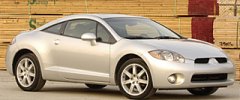 Mitsubishi's
affordable coupe was started by Starion in the mid-80s. It was a
compact, good-looking 2+2 coupe powered by a powerful 2-litre turbo
engine. Compare to established Japanese coupes like Nissan 300ZX and
Toyota Supra, the Starion was a pocket rocket, fast yet cheap. In 1989,
Starion transferred its winning genes to Eclipse. The first generation
Eclipse was even more powerful, faster and more stylish than Starion.
Its 2-litre 16V turbo engine produced 195 horsepower, enabling the car
to storm from 0 to 60 mph in 6.8 second ! Suddenly every boy-racer in
the USA wanted to buy an Eclipse, especially the AWD version. The love
affair of Eclipse continued in the second generation (born in 1994),
which was an evolution of the previous car. Unfortunately, Mitsubishi
changed its strategy in 1999. The third generation Eclipse grown
bigger, heavier and more civilized. Its 200hp 3.0
V6 was actually a sedan engine. The car lost its sharp edge, so did the
love from its fans. Mitsubishi's
affordable coupe was started by Starion in the mid-80s. It was a
compact, good-looking 2+2 coupe powered by a powerful 2-litre turbo
engine. Compare to established Japanese coupes like Nissan 300ZX and
Toyota Supra, the Starion was a pocket rocket, fast yet cheap. In 1989,
Starion transferred its winning genes to Eclipse. The first generation
Eclipse was even more powerful, faster and more stylish than Starion.
Its 2-litre 16V turbo engine produced 195 horsepower, enabling the car
to storm from 0 to 60 mph in 6.8 second ! Suddenly every boy-racer in
the USA wanted to buy an Eclipse, especially the AWD version. The love
affair of Eclipse continued in the second generation (born in 1994),
which was an evolution of the previous car. Unfortunately, Mitsubishi
changed its strategy in 1999. The third generation Eclipse grown
bigger, heavier and more civilized. Its 200hp 3.0
V6 was actually a sedan engine. The car lost its sharp edge, so did the
love from its fans.
 You might
think Mitsubishi would learn from its failure. Sorry, it didn't. You might
think Mitsubishi would learn from its failure. Sorry, it didn't.
The latest, Mk4 Eclipse is not only
again a big and heavy machine, but it is actually bigger and heavier
than the Mk3 ! Its body measures some 11cm longer, 8.5cm wider and 5cm
taller, while kerb weight has increased by 150 kg !
The new Eclipse
again employs a naturally aspirated V6 (and a 2.4-litre 4-cylinder
engine for the base model). However, to achieve hotter
performance, the V6 is enlarged to 3.8 litres and its SOHC cylinder
heads are added with MIVEC variable valve timing and lift. The result
is a competitive 263 horsepower and 260 lbft of torque. These enable
the new car to sprint to 60 mph in about 6 seconds, not much behind
performance leaders Nissan 350Z and Ford Mustang GT. However, the V6 is
short of excitement. It is a lazy, torque-biased engine. Its max power
is extracted at only 5750 rpm like a pushrod engine.
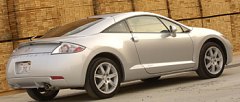 In terms
of handling, the big Eclipse suffers. Not only the size and weight, the
front-drive layout and poor weight distribution also work against
handling. For cost reasons, the Eclipse is built on the Galant
platform. This allows it to be produced at the USA plant alongside the
Galant, but it also means its fundamental was designed for family
sedan. The Galant is big, so is the Eclipse. The Galant employs a heavy
iron-block 3.8 V6, so does the Eclipse. No wonder the latter has 62%
of weight suspended over the front wheels. The result is a lot of
understeer that you won't expect in a coupe. You know, when a car
understeers heavily into corners, there is no fun to talk about. In terms
of handling, the big Eclipse suffers. Not only the size and weight, the
front-drive layout and poor weight distribution also work against
handling. For cost reasons, the Eclipse is built on the Galant
platform. This allows it to be produced at the USA plant alongside the
Galant, but it also means its fundamental was designed for family
sedan. The Galant is big, so is the Eclipse. The Galant employs a heavy
iron-block 3.8 V6, so does the Eclipse. No wonder the latter has 62%
of weight suspended over the front wheels. The result is a lot of
understeer that you won't expect in a coupe. You know, when a car
understeers heavily into corners, there is no fun to talk about.
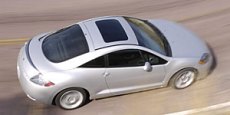 With so
much torque sent to the front wheels, torque steer is inevitable. This
is not helped by the low-cost MacPherson strut front suspension, which
is more prone to torque steer than other suspension designs (that's why
those FWD Audi and Alfa Romeo employ 4-link and double-wishbone front
suspensions respectively). Again, the MacPherson strut was originally
designed for Galant rather than a performance car. Disappointingly,
Mitsubishi offers neither AWD nor limited-slip differential, giving up
the last chance to cure the torque steer. Whenever
you apply throttle in tight corners, the Eclipse's power will fight
with your arms to resist your steering action. If you drive hard
enough, the strong torque may even spin the unloaded inside front wheel
! With so
much torque sent to the front wheels, torque steer is inevitable. This
is not helped by the low-cost MacPherson strut front suspension, which
is more prone to torque steer than other suspension designs (that's why
those FWD Audi and Alfa Romeo employ 4-link and double-wishbone front
suspensions respectively). Again, the MacPherson strut was originally
designed for Galant rather than a performance car. Disappointingly,
Mitsubishi offers neither AWD nor limited-slip differential, giving up
the last chance to cure the torque steer. Whenever
you apply throttle in tight corners, the Eclipse's power will fight
with your arms to resist your steering action. If you drive hard
enough, the strong torque may even spin the unloaded inside front wheel
!
Braking power and grip from its all-season tires are also
disappointing, as is body control. Th Eclipse rolls quite a lot in
corners because its suspensions are set soft. In return, it gets a
smoother ride than most other rivals. The slightly stiffer chassis
(torsional rigidity up by 11%) also reduces vibration and noise
entering the cabin.
So, maybe this is a comfort-biased coupe...
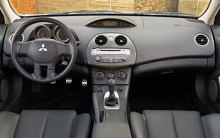 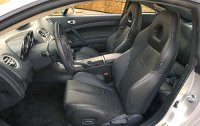 Maybe
not. If you look at the cabin, you will find the dashboard is made of
poor quality plastics and offers little storage space. Front passenger
space is acceptable, but the rear seat is purely for small children or
dogs. In fact, rear seat room is actually smaller than the Mk3, even
though the car has grown a lot in exterior dimension. Maybe
not. If you look at the cabin, you will find the dashboard is made of
poor quality plastics and offers little storage space. Front passenger
space is acceptable, but the rear seat is purely for small children or
dogs. In fact, rear seat room is actually smaller than the Mk3, even
though the car has grown a lot in exterior dimension.
Unquestionably, rear accommodation is sacrificed for styling reasons.
Viewing from the tail, the Eclipse's sharp-angle fastback looks very
sporty. However, you may also notice the rear end styling is clearly a
copy of Audi TT Coupe. Too bad. In contrast, the front end styling is
purely original, but it is also the ugliest place of the car.
Mitsubishi's stylists seemed unaware that organic styling theme has
long past its golden time.
So the new Eclipse is fast but unexciting, civilized to drive but not
very practical, looks aggressive but not tasteful. Summing all up, it
seems that the new Eclipse is already eclipsed by many other good
coupes. |